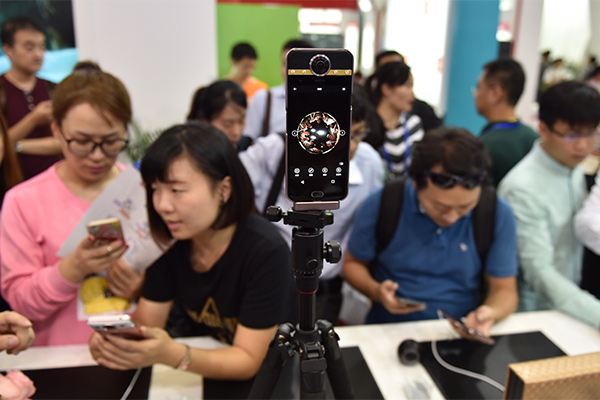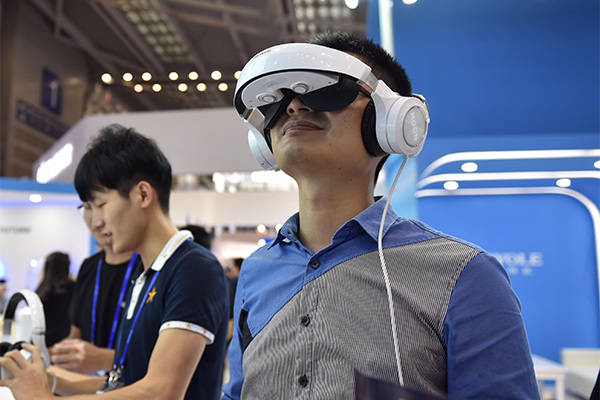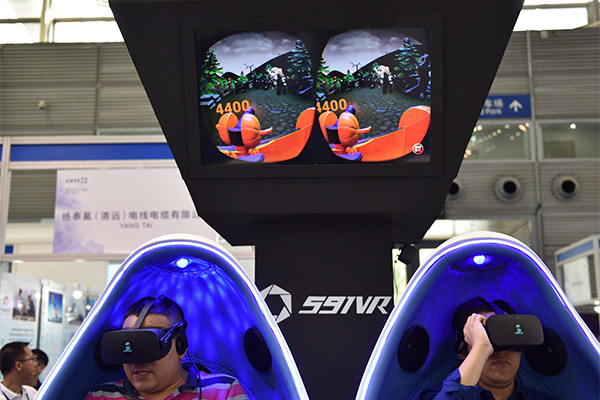
A man experiences a virtual reality (VR) game at the China High-Tech Fair in Shenzhen, south China’s Guangdong province, Nov 17, 2016.[Photo/Xinhua]
SHENZHEN — A mining truck made in China and powered by a new type of lithium battery drew crowds at an ongoing technology fair in the southern Chinese city of Shenzhen.
Jointly developed by mining machinery maker Dongfeng Heavy Industry and Shenzhen Guochuang Power System Company, the truck uses 50 to 70 percent less fuel compared to traditional mining trucks.
It has a maximum carrying capacity of 60 tonnes, versus 25 tonnes for mining trucks developed previously in China, according to Huang Xingguang, general manager of Dongfeng Heavy Industry.
The 18th China High-Tech Fair, slated for Nov 16 to 21, has attracted more than 3,000 exhibitors from 37 countries. The event showcases some of the world’s most advanced technology, featuring everything from non-invasive diabetes tests and an underwater glider to a robot that helps patients recover from leg injuries.
“The fair has become a showcase and trading platform for high-tech products with a large scale and far-reaching influence. It helps promote the development of the high-tech industry and improve independent innovation capability,” said Zhang Ji, an official with the Ministry of Commerce.

Audience experience a smartphone which can shoot VR photos and videos at the China High-Tech Fair in Shenzhen, south China’s Guangdong province, Nov 17, 2016.[Photo/Xinhua]
Among the exhibits is a clinical whole body magnetic resonance imaging (MRI) system developed by Shenzhen Institutes of Advanced Technology under the Chinese Academy of Sciences. It is said to be the first machine of its kind with intellectual property rights completely held by China.
Head of the institute Fan Jianping said that during the first half of 2016, the MRI system ranked third in China in market share. “The system has broken the monopoly of multinational companies such as GE, Philips and Siemens, and demonstrated our developers’ great innovative ability,” he added.
Lu Yongxiang, academician of the Chinese Academy of Sciences and the Chinese Academy of Engineering, said China has been leading the world in terms of supercomputing and quantum communication. The country also boasts world-class technology in the internet, expressways, rail transit and wireless broadband infrastructure.
China also excels in the development of wind power, photovoltaic power, hydropower, and ultra-high voltage power transmission as well as gene sequencing, breeding, and editing, he said.

A man experiences a head-wear 3D cinema at the China High-Tech Fair in Shenzhen, south China’s Guangdong province, Nov 17, 2016. [Photo/Xinhua]
However, the country is still largely reliant on imports of core technology, key materials and components. Independent design and development ability is still weak and some industries are plagued with overcapacity.
In 2015, China unveiled the “Made in China 2025” blueprint, which aims to improve manufacturing and shift the country away from low-end manufacturing to more value-added production.
Christopher Pissarides, Nobel Prize Laureate in Economic Sciences, said during the fair the “Made in China 2025” blueprint will improve the technological capabilities of Chinese industries and promote the development of the service sector.
China plays an important role in the world economy. Western countries expect that China can grow into a new leader for the world’s economic growth, he said.
However, in order to achieve that, China should invest more in research and development and upgrade its consumption, and it also needs a more dynamic financing sector, he said.

Audience experience a VR game at the China High-Tech Fair in Shenzhen, south China’s Guangdong province, Nov 17, 2016. [Photo/Xinhua]
